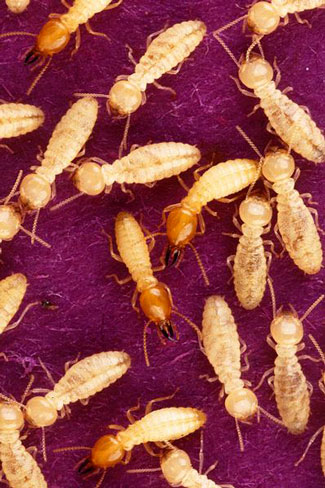Which Termite Eats the Most?
By Chris Williams on October 6, 2014.
I’ve read that Formosan termites can cause a lot of damage to a home in a relatively short time. I’ve also read that we don’t have Formosan termites here in the Northeast. How worried do we really need to be about termite damage? C.C., Sutton, MA

Formosan termites, which aren’t found in the Northeast U.S.
It’s true that Formosan termites are really bad dudes. And it’s true that we don’t have Formosans in most of the U.S. Formosan subterranean termites were first reported in New Orleans in the 1950’s and have since spread to include most of the Gulf and southern Atlantic coastal states, as far north as Virginia. They are also found in southern California, and Hawaii.
Formosan termites fall into the category of subterranean termites which means that they live in the ground and move from there into wood, usually. In areas with high moisture content, Formosans can establish above-ground nests with no need to return to the ground. The Formosan termite can have huge swarming flights with up to 70,000 winged termites emerging from a single ground colony.
We Have the Eastern Subterranean Termite Instead
The only termites that cause a problem for homeowners in Massachusetts and New Hampshire are the Formosans’ cousins, the eastern subterranean termites. They also live in the ground and infest wood that is either underground or above-ground. Termites are soft-bodied and dry out easily. If they have to move above ground, termites will construct mud tubes between their soil colony and the wood that they are feeding on.
Colony Size Does Make a Difference
A single Formosan termite doesn’t eat any more wood than a single native termite, but their colonies are huge. A small-sized Formosan subterranean termite colony has 250,000 termites. An average size eastern subterranean termite colony contains about 60,000 termites. To give you an idea of the possible difference in damage, theoretically the colony of native termites would require 6 months to consume a foot of a pine 2X4 board. The colony of Formosan termites could consume that same foot of 2X4 in less than a month, or about seven times faster. Most Formosan subterranean termite colonies are even bigger, about 3 million termites, with an exponentially bigger damage potential (see How Much Can Termites Eat in a Year?).
Formosans outcompete our native termites in other ways, too. They build more extensive mud tubes and forage greater distances looking for food. Formosans feed on a greater variety of woods and will even attack live trees. They also feed on both the spring and summerwood portions, while eastern subterranean termites usually eat only the softer springwood. In the warm regions where Formosan termites occur, they can remain active and feed year-round. Fortunately, in the Northeast, our termites become less active when the ground is frozen…unless they are inside a building.
So, while our termites are not as scary as Formosan termites, they’re no slouches. Do not take them for granted. Keep the wood in your home dry, make sure you have a current termite treatment or baiting system in place, and call an exterminator for regular termite inspections.
By Scott Bauer, U.S. Department of Agriculture [Public domain], via Wikimedia Commons